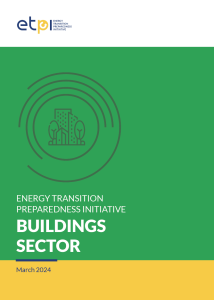Deepak Tewari, Rushabh Soni, Bharath Jairaj, Sumedha Malaviya, Catherine Ayallore, Sarada Prasanna Das, Shantanu Dixit, Pooja Gangwar, Ann Josey, Manasi Jog, Vaisakh Kumar, Shivani Kokate, Harish Palani , Varun Potty, Ramesh S, Jyoti Sharma, Ashwini Swain, Dhilon Subramanian and Niharika Tagotra
Energy Transitions
| ETPI |28 May 2024
Energy Transitions Preparedness Initiative: Buildings Sector

Executive Summary
- India’s buildings sector will play a critical role in meeting the country’s climate targets while promoting resilient cities (IEA 2021b). Buildings also represent the demand side of the energy transition, which is otherwise generally dominated by discourses on the supply side. The sector is undergoing clean energy transition while also contributing to it. Urgent political attention and coordinated action between national and sub-national actors across the buildings value chain are needed if energy transition goals must be achieved in a cost-effective and timely manner.
- The Energy Transition Preparedness Initiative (ETPI) provides a framework to study and understand state-level plans, actions, and governance processes towards energy transition. The framework covers multiple themes in 24 indicators, representing crucial aspects of energy transition in the electricity, buildings, and transport sectors. The buildings sector covers many themes across five indicators.
- Buildings are a state subject and therefore energy transition actions in the sector must be studied at the state level. Evidence suggests that buildings are contributing to national and state-level energy transition goals in many ways. There are examples of effective and ambitious policy initiatives with varying scales of action to facilitate transition. Despite the progress, greater efforts are required to implement stated policies in order to achieve the sector’s transition objectives.
- This study aims to understand the energy transition preparedness of the buildings sector of 10 states in India and highlights good examples from the states. Drawing on information available in the public domain, it sheds light on the level of energy transition preparedness in these states for FY 2020-21.
- This report studies energy transition preparedness across multiple states, facilitates cross learning between them, and promotes adoption of approaches suitable to their specific contexts.




